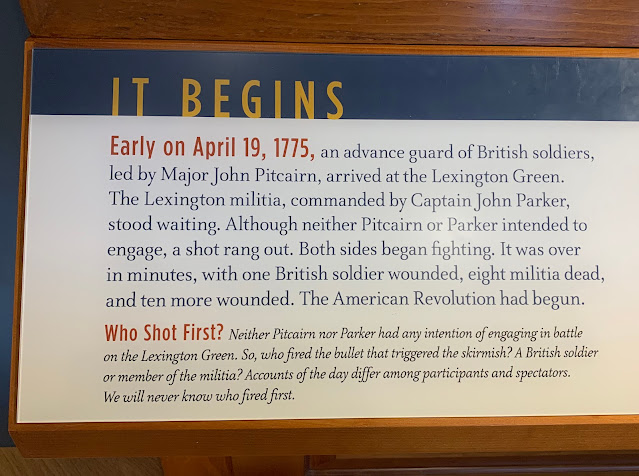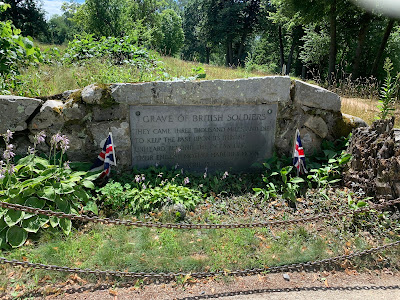Time to move on and start visiting some Revolutionary War sites. We started in Lexington and Concord, Massachusetts.
We went into historical Lexington and saw a few interesting things.
The Buckman Tavern was a gathering place for both locals and travelers, and the site of many important town meetings. Captain Parker and his militia gathered in this tavern in the early morning of April 19, 1775 to await the oncoming British Redcoat troops.
Revolutionary War Monument
The Revolutionary War monument, constructed in 1799, is one of the nation's oldest war memorials. Seven Minutemen are buried at its base.
We were standing where the American Revolution began. The Lexington Green was the site of a skirmish between Colonial and British forces on the morning of April 19, 1775. The battle only lasted a few minutes.
From Lexington, the British troops headed to neighboring Concord. There, the Colonists prevailed, forcing the British troops to retreat. The twin battles of April 19, 1775 set in motion an eight year fight for American independence.
Minuteman Statue
Unveiled in 1900, the Minuteman Statue was created by Boston sculptor Henry H. Kitson and honors Captain John Parker and the Lexington Militia.
We left the area and drove to Concord. We stopped at the Minute Man Historical Park - quite a different Visitor Center.
The movie explaining the events was one of the most well-done movies we've seen in a Visitor Center.
This is an example of the tool that the Militia used to create mini-balls. They would super heat lead in a ladle and while molten, poured it into a hole on the side of this tool. After cooling, they opened it up like a pair of scissors and used the snipping portion that is seen between the top and bottom handle and snipped off the excess lead that was protruding through the hole.
It was a beautiful, although hot, walk to the bridge. These folks didn't look so hot.
We were standing in the approximate area of their burial site
Another long walk to the Visitor Center.
The Hancock Cannon
The Hancock Cannon is a rare Revolutionary War cannon with an extraordinary tie to Concord. It may have played a significant role in the start of the war.
In September, 1774, Boston Patriots brazenly stole four brass cannons right from under the British guard. The cannons were smuggled out of Boston and added to the growing caches of Colonial arms.
General Gage showed a special interest in recovering the cannons. Because they were stolen, he may have felt more justified in seizing them. Also, brass cannons were more valuable as field artillery than iron because they were lighter and more maneuverable.
In February, 1775, records of the Committees of Safety and Supplies indicate that the stolen cannons were moved to Concord. In March, Gage received a spy report from Concord that four brass cannons were "Conceal'd at Mr. B, (Lately chose or appointed Minute Colo.) Suppos'd to be deposited in his cellar." Concord's new Colonel was James Barrett.
Ten iron cannons were also reported to be in the town. In April, General Gage ordered the expedition to Concord for the purpose of seizing and destroying colonial weapons stockpiles, including cannon. Barrett's farm, a mile and a half beyond the North Bridge, was the furthest point from Boston that was searched by the British troops.
The cannons were not found, since the Colonists had enough advance warning to move them. The four brass cannons were used through the Revolution. Two of them, while in Canada, were captured by the British.
After the war's end, the remaining two were returned by Congress to Massachusetts, christened "The Hancock" and "The Adams" and inscribed. In 1843, they were installed at the top of the Bunker Hill Monument, where "The Adams" remains to this day.
And then it was time to drive into the historic town of Concord. We had passed a quaint little spot and decided to stop there for lunch.
Love it when we get a great parking spot
What an interesting day but more to come in the next few days.
























I know this area very well. We lived just a few miles from Lexington in the neighboring town of Arlington for six years. And good friends now live near Concord. But I don't think we've ever been to either visitor center!
ReplyDeleteIt seems difficult for us to take the time to "sightsee" in our home area.
Delete